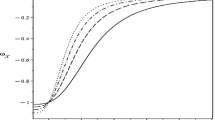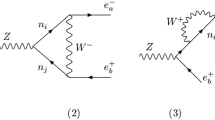Abstract
We estimate the baryon asymmetry, mass of inflaton and reheating temperature in different neutrino mass models with and without θ13 by considering the three diagonal form of Dirac neutrino mass matrices. The predictions of any models with θ13 are consistent in all the three stages of leptogenesis calculations and the results are also better than the predictions of the models without θ 13 and are consistent in a piecemeal manner with the observational data. Further, we observe that for neutrino mass models with vanishing θ 13, contribution of muon predominates over electron and tau contributions and full flavour regime M1 ≤ 109 GeV is more favourable, whereas for neutrino mass models with non-vanishing θ 13, contribution of tau predominates over electron and muon contributions and two flavours regime (109 ≤ M1 ≤ 1012) GeV is also possible besides three flavours regime. The predicted inflaton mass required to produce the observed baryon asymmetry and the corresponding reheating temperatures apply to recent discovery of Higgs boson of mass ~125 GeV.
Similar content being viewed by others
References
Y Fukuda et al. [Super-Kamiokande Collaboration] Phys. Rev. Lett. 81 1562 (1998)
M Apollonio et al. [CHOOZ Collaboration] Phys. Lett. B 466 415 (1999)
Q Ahmad et al. [SNO Collaboration] Phys. Rev. Lett. 89 011301 (2002)
Q Ahmad et al. [SNO Collaboration] Phys. Rev. Lett. 92 181301 (2004)
K Eguchi et al. [KamLAND Collaboration] Phys. Rev. Lett. 90 021802 (2003)
M Ahn et al. [K2K Collaboration] Phys. Rev. D 74 072003 (2006)
F P An et al. [Daya-Bay Collaboration] Phys. Rev. Lett. 108 171803 (2012)
F P An et al. [Daya-Bay Collaboration] Chin. Phys. C 37 011001 (2013)
Y Abe et al. [DOUBLE-CHOOZ Collaboration] Phys. Rev. Lett. 108 131801 (2012)
Y Abe et al. [DOUBLE-CHOOZ Collaboration] Phys. Rev. D 86 052008 (2012)
J K Ahn et al. [RENO Collaboration] Phys. Rev. Lett. 108 191802 (2012)
K Abe et al. [T2K Collaboration] Phys. Rev. Lett. 107 041801 (2011)
D Michael et al. [MINOS Collaboration] Phys. Rev. Lett. 97 191801 (2006)
D Michael et al. [MINOS Collaboration] Phys. Rev. Lett. 107 181802 (2011)
C L Bennett et al. arXiv: 1212.5225 (2013)
G Hinshaw et al. arXiv: 1212.5226 (2012)
P A R Ade et al. [Planck Collaboration], arXiv: 1303.5076 (2013)
A D Sakharov Pisma Zh. Eksp. Teor. Fiz. 5 32 (1967)
M Fukugita and T Yanagida Phys. Lett. B 174 45 (1986)
M A Luty Phy. Rev. D 45 455 (1992)
M Gell-Mann, P Ramond and R Slansky Supergravity (eds.) P Van Nieuwenhuizen and D Z Freedman (Amsterdam: North-Holland) p 315 (1979)
S Blanchet and P Di Bari J. Cosmol. Astropart. Phys. 0703 018 (2007)
E Ma, N Sahu and U Sarkar J. Phys. G 34 741 (2007)
V S Rychkov and A Strumia Phys. Rev. D 75 075011 (2007)
T Fukuyama, T Kikuchi and T Osaka JCAP 06 005 (2005)
M Kawasaki, K Kohri and T Moroi Phys. Rev. D 71 083502 (2005)
B Garbrecht, F Glowna and P Schwaller Nucl. Phys. B 66 89 (2013)
T Fukuyama and H Nishiura arXiv:hep-ph/9702253 (1997)
G Altarelli and F Feruglio Phys. Rep. 320 295 (1999)
K Nakamura et al. Particle data Group JPG 37 075021 (2010)
G L Fogli, E Lisi, A Marrone, A Palazzo and A M Rotunno Phys. Rev. D 84 053007 (2011)
A Osipowicz et al. (KATRIN Collaboration) arXiv:hep-ex/0109033 (2001)
I Avignone, T Frank, S R Elliott and J Engel Rev. Mod. Phys. 80 481 (2008)
J Lesgourgues and S Pastor Adv. High Energy Phys. 2012 608515 (2012)
P Ade et al. (Planck Collaboration) arXiv:hepph: 1303.5076 (2013)
E Nardi, Y Nir, E Roulet and J Racker JHEP 0601 164 arXiv:hep-ph/0601084 (2006)
Ng K Francis and N N Singh Nucl. Phys. B 863 19 (2012)
T Kalaydzhyan and I Kirsch, Phys. Rev. Lett 106 211601 (2011)
T Endoh, S Kaneko, S Kang, T Morozumi and M Tanimoto J. Phys. G 29 1877 arXiv:hep-ph/0209098 (2002)
M Flanz, E A Paschos, U Sarkar Phys. Lett. B 345 248 (1995)
W Buchmuller, P D Bari and M Plumacher Nucl. Phys. B 665 445 (2003)
K S Babu, A Bachri and H Aissaoui Nucl. Phys. B 738 76 (2006)
R Barbieri, P Creminelli, A Strumia and N Tetradis Nucl. Phys. B 575 61 (2000)
S Davidson, E Nardi and Y Nir Phys. Rep. 466 105 (2008)
G Lazarides and Q Shafi Phys. Lett. B 258 305309 (1991)
K Hamaguchi, M Kawasaki and T Yanagida Phys. Rev. D 65 043512 (2002)
J R Ellis, A D Linde and D A Nanopoulos Phys. Lett. B 118 59 (1982)
Acknowledgments
The author wishes to thank Prof. Ignatios Antoniadis of CERN, Geneva, Switzerland, for making comment on the manuscript and to Prof. M. K. Chaudhuri, the Vice-Chancellor of Tezpur University, for granting study leave with pay where part of the work was done during that period.
Author information
Authors and Affiliations
Corresponding author
Rights and permissions
About this article
Cite this article
Francis, N.K. Neutrino mass models with and without θ 13 in predicting leptogenesis. Indian J Phys 89, 857–867 (2015). https://doi.org/10.1007/s12648-015-0646-3
Received:
Accepted:
Published:
Issue Date:
DOI: https://doi.org/10.1007/s12648-015-0646-3




